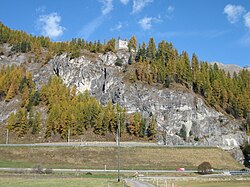Guardaval Castle
| Guardaval Castle | |
|---|---|
| Madulain | |

Ruins of Guardaval
|
|
| Coordinates | 46°35′08″N 9°55′59.59″E / 46.58556°N 9.9332194°ECoordinates: 46°35′08″N 9°55′59.59″E / 46.58556°N 9.9332194°E |
| Type | hill castle |
| Code | CH-GR |
| Height | 1,785 m above the sea |
| Site information | |
| Condition | Ruin |
| Site history | |
| Built | 13th century |
Guardaval Castle is a ruined castle in the municipality of Madulain of the Canton of Graubünden in Switzerland.
Guardaval Castle was built around 1250 near the village of Madulain to administer the estates of the Bishop of Chur in the Upper Engadine by Bishop Volkard von Neuenburg. The castle sat along the Albula Pass road and collected tolls from travelers going over the pass. The castle was an important administrative center for the bishops, they often took up residence in the castle and ordered their vassals to frequently repair and hold it always available to them. Originally the castle consisted of just the main tower. The second building phase added a curtain wall, a gatehouse to the south, a zwinger or outer courtyard and a residential wing to the east.
In the 14th century the castle was granted to the wealthy Planta family from nearby Zuoz. The Planta family held a number of estates throughout the Engadine region as well as the rights to mine in the valley and fish on its lakes. Throughout the 14th century, they held the castle as a fief and sometimes as collateral for a loan that they gave the bishop. In 1359 the bishop visited the castle and issued documents from his residence in castro nostro Wardenwall.
In 1367 the Planta family supported the creation of the League of God's House to curtail the power of the bishops. The bishop, trying to retain his power base at Guardaval, required Thomas von Planta (in 1377) and his son Jacob (in 1382) to swear that they would always hold the castle open for the bishop and keep it in good repair. In 1409 the Bishop had to pledge the castle to the League of God's House to pay off some of his debts. Under the League, the castle was no longer an administrative center and was abandoned by 1500, falling into ruin.
...
Wikipedia


